Honda Pilot: Seat Belts
Seat belts are recognized as the single most effective safety device in a vehicle. They keep you securely attached to the vehicle, enabling you to benefit from its various built-in safety features. In a collision, seat belts prevent you from being thrown against the vehicle's interior, against other passengers, or out of the vehicle. When properly worn, seat belts also help position your body correctly to maximize the protection offered by the airbags. The Honda Pilot 2023 emphasizes these safety principles, ensuring that seat belts are a key component of its comprehensive safety system.
About Your Seat Belts
Seat belts are the single most effective safety device in any vehicle. They keep you securely connected to the vehicle, allowing you to benefit from many of the built-in safety features. Properly worn seat belts prevent you from being thrown against the interior of the vehicle, other passengers, or out of the vehicle during a collision. In addition, they help keep your body properly positioned in the event of a crash, ensuring you can take full advantage of the additional protection provided by the airbags. The 2023 Honda Pilot is designed with these principles in mind to maximize occupant safety.
Seat belts are crucial for maximizing the effectiveness of your vehicle's safety systems. By keeping you securely connected to the vehicle, seat belts allow you to utilize the many built-in safety features fully. They prevent occupants from being thrown against the inside of the vehicle, other passengers, or ejected during a collision. Furthermore, seat belts ensure your body remains in the correct position during a crash, allowing the airbags to provide optimal protection. The Honda Pilot 2023 is engineered to enhance these safety benefits, underscoring the importance of always wearing your seat belt.
In addition, seat belts help protect you in almost every type of crash, including:
- frontal impacts
- side impacts
- rear impacts
- rollovers
■ Lap/shoulder seat belts
All seven or eight seating positions in the vehicle are equipped with lap/shoulder seat belts featuring emergency locking retractors. These retractors allow passengers to move freely under normal driving conditions while maintaining some tension on the belt. During a collision or sudden stop, the retractors lock to securely restrain occupants' bodies. Additionally, the front passenger, second row, and third row seat belts come with lockable retractors specifically designed for use with child seats, ensuring enhanced safety for younger passengers. These safety features are integral to the design of the Honda Pilot 2023.
Each of the seven or eight seating positions in the vehicle is equipped with lap/shoulder seat belts that include emergency locking retractors. Under normal driving conditions, these retractors allow for free movement while keeping the seat belts slightly tensioned. In the event of a collision or sudden stop, the retractors lock to provide effective restraint. The front passenger, second row, and third row seat belts are also fitted with lockable retractors, making them suitable for securing child seats and enhancing passenger safety. These comprehensive seat belt features are key components of the Honda Pilot 2023.
In the vehicle, all seven or eight seating positions come with lap/shoulder seat belts that feature emergency locking retractors. These retractors permit free movement during normal driving while maintaining necessary tension on the belt. During a collision or abrupt stop, the retractors lock to ensure the occupants' bodies are securely restrained. Furthermore, the seat belts for the front passenger, second row, and third row include lockable retractors to facilitate the safe use of child seats. This advanced seat belt system underscores the commitment to passenger safety in the Honda Pilot 2023.
WARNING
Not wearing a seat belt properly increases the chance of serious injury or death in a crash, even though your vehicle has airbags.
Be sure you and your passengers always wear seat belts and wear them properly.
If you extend the seat belt too quickly, it will lock in place. If this happens, slightly retract the seat belt, then extend it slowly.
Seat belts cannot completely protect you in every crash. But in most cases, seat belts can reduce your risk of serious injury.
Most states and all Canadian provinces and territories require you to wear seat belts.
■ Proper use of seat belts
Follow these guidelines for proper use:
- All occupants should sit upright, well back in the seat, and remain in that position for the duration of the trip. Slouching and leaning reduce the effectiveness of the belt and can increase the chance of serious injury in a crash.
- Never place the shoulder part of a lap/shoulder seat belt under your arm or behind your back. This could cause very serious injuries in a crash.
- Two people should never use the same seat belt. If they do, they could be very seriously injured in a crash.
- Do not put any accessories on the seat belts. Devices intended to improve comfort or reposition the shoulder part of a seat belt can reduce the protective capability and increase the chance of serious injury in a crash.
If a rear seat passenger moves around and extends the seat belt, the lockable retractor may activate. If this happens, release the retractor by unfastening the seat belt and allow the belt to retract completely.
Then refasten the belt.
■ Seat Belt Reminder
Front seats
The seat belt system in the Honda Pilot 2023 includes a helpful indicator on the instrument panel to remind the driver and front passenger to fasten their seat belts. When the power mode is set to ON and a seat belt is not fastened, a beeper will sound and the indicator will blink. After a few seconds, the beeper will stop, but the indicator will remain illuminated until the seat belt is fastened. While the vehicle is moving, the beeper will periodically sound, and the indicator will continue to blink until the seat belt is secured. This system is designed to ensure that all occupants remain safe and compliant with seat belt regulations.
Pilot Honda is equipped with a seat belt reminder system that features an indicator on the instrument panel to prompt the driver and front passenger to buckle up. When the power mode is switched to ON and a seat belt is not fastened, a beeper will sound and the indicator will blink to alert the occupants. After a few seconds, the beeper will cease, but the indicator will stay on until the seat belt is properly fastened. Additionally, while the vehicle is in motion, the beeper will periodically sound, and the indicator will blink to ensure continuous reminders until the seat belt is fastened. This thoughtful feature underscores the importance of safety in the Honda Pilot 2023.
The seat belt system is designed with safety in mind, featuring an indicator on the instrument panel to remind the driver and front passenger to fasten their seat belts. When the power mode is activated and a seat belt is not fastened, a beeper will sound and the indicator will blink as a reminder. After a few seconds, the beeper will stop, but the indicator will remain lit until the seat belt is secured. Moreover, if the vehicle is moving and the seat belt is not fastened, the beeper will periodically sound, and the indicator will continue to blink. This consistent reminder system helps ensure that all occupants use their seat belts, reinforcing safety in the Honda Pilot 2023.
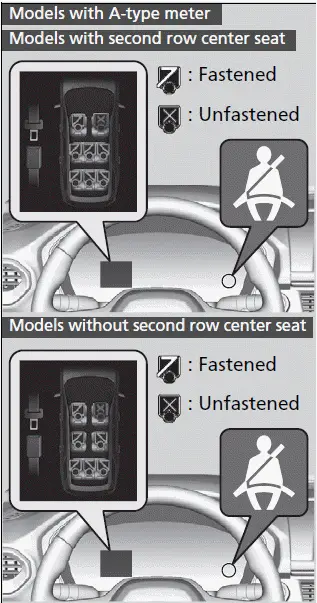
The indicator will also come on if a front passenger does not fasten their seat belt within six seconds after the power mode is set to ON.
When no one is sitting in the front passenger's seat, the indicator will not come on and the beeper will not sound.
The indicator also may not come on and the beeper may not sound when the occupant is not heavy enough to trigger the weight sensor. Such occupants (e.g., infants and smaller children) should be moved to the rear seat as a deploying front airbag likely will injure or kill them.
The driver information interface uses colors to aid the driver in checking the status of the passengers.
For the front seating positions:
- Green indicates the seat belt is fastened.
- An unfastened gray graphic indicates the seat belt is not fastened and an occupant has not been detected.
- An unfastened red graphic indicates the seat belt is unfastened and an occupant has been detected.
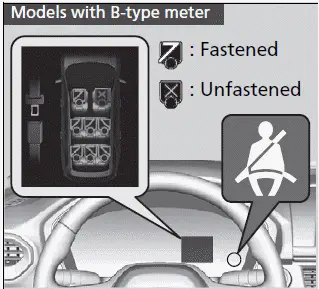
Rear seats
Your vehicle keeps track of rear seat belt usage. The driver information interface will notify you if any of the rear seat belts become unfastened after being previously fastened.
In order to encourage the driver to evaluate rear seat belt usage, the display appears when:
- Any of the rear passenger seat belts are unfastened when the power mode is set to ON.
- Any of the rear passengers unfasten their seat belt.
The seat belt reminder indicator blinks and the beeper sounds if any rear passenger seat belts are unfastened while driving.
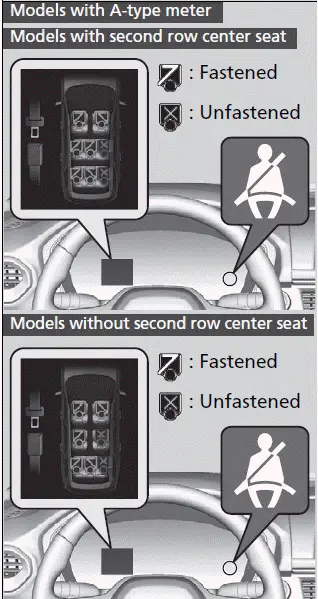
The system will not detect a passenger in the rear seats who has not fastened the seat belt.
The driver should check the status of the rear passengers' seat belts at the start of each trip and each time a passenger is seated in the rear seats, using the driver information interface as an aid.
An alert will sound if a passenger in the rear seats unfastens the seat belt while the vehicle is in motion or if motion resumes while the graphic is red.
The driver information interface uses colors to aid the driver in checking the status of the passengers.
For the rear seating positions:
- Green indicates the seat belt is fastened.
- An unfastened gray graphic indicates the seat belt has not been fastened recently.
- An unfastened red graphic indicates the seat belt was unfastened recently.
The system does not monitor harnesses that are part of a child seat, the anchors of the LATCH system, the installation of a removable seat, or the anchor buckles of the second and third row center seat belts.
While the system can inform you that a seat belt buckle is fastened, it cannot determine whether the seat is properly installed, the center seat belt anchors are in use, or if a child seat is properly installed or used.
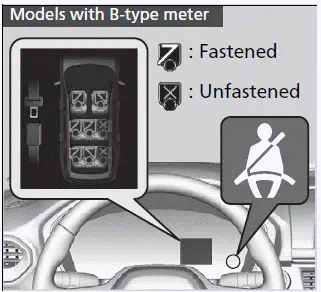
Models equipped with a removable seat
A transceiver is installed in the removable seat to wirelessly communicate seat belt fastening information to the vehicle. It will automatically connect to the vehicle whenever the seat is in or near its installation position. Radio waves are transmitted to and from the transceiver in the removable seat to obtain the seat belt status. This ensures that the vehicle always has accurate information about seat belt usage, enhancing safety features in the Honda Pilot 2023.
In the following cases, the seat belt may be displayed as unfastened even if it is fastened:
- Strong radio waves are being transmitted by nearby equipment, such as a wireless phone charger.
- Telecommunications equipment, a laptop computer, cell phone, wireless device, or another high-powered electronic device is placed in, under, or close to the removable seat.
- A metallic object is covering all or part of the seat, or a large metallic object is placed in the cabin in a way that is blocking the vehicle's antennas from communicating with the transmitter in the seat.
- The battery in the transceiver dies.
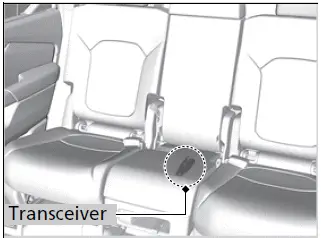
Electronic devices can create radio frequencies which interfere with the wireless seat belt reminder communication. If the system does not function as expected, please check that such items are not in, under or adjacent to the removable seat. Then turn the ignition off and then on again. If the malfunction continues, please see your dealer.
The transceiver has a specially designed coin-cell battery that needs to be replaced periodically. Battery life is about five years, but this varies depending on regularity of use.
The battery can be consumed whenever the seat transceiver is receiving strong radio waves. Avoid placing high powered electrical devices in or near the removable seat, such as gaming consoles or wireless chargers.
If the battery is low or the seat belt reminder is no longer working, please see your dealer to have the battery replaced.
WARNING
CHEMICAL BURN HAZARD
The battery that powers the seat belt transceiver can cause severe internal burns and can even lead to death if swallowed.
Keep new and used batteries away from children.
If you suspect that a child has swallowed the battery, seek medical attention immediately.
If the vehicle loses connection with the transceiver while the seat belt is fastened, the information for that seat will change to unfastened, and a "Seat belt reminder system problem" warning will be displayed.
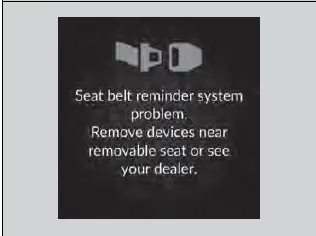
■ Automatic Seat Belt Tensioners
The front seats and the outer seats of the second row in the Honda Pilot 2023 are equipped with automatic seat belt tensioners to enhance safety. These tensioners automatically tighten the seat belts during a moderate-to-severe frontal collision. This occurs even if the collision is not severe enough to deploy the front airbags or the driver's and passenger's knee airbags. This feature ensures additional protection for occupants by securing them more firmly in their seats.
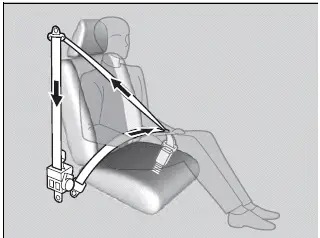
The seat belt tensioners can only operate once.
If a tensioner is activated, the SRS indicator will come on. Have a dealer replace the tensioner and thoroughly inspect the seat belt system as it may not offer protection in a subsequent crash.
During a moderate-to-severe side impact, the tensioner on both sides of the vehicle also activates.
Fastening a Seat Belt
After adjusting a front seat to the proper position, and while sitting upright and well back in the seat:
1. Pull the seat belt out slowly.
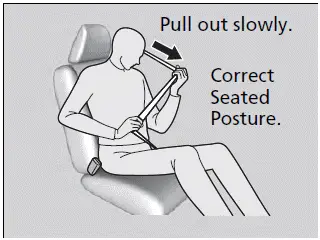
2. Insert the latch plate into the buckle, then tug on the belt to make sure the buckle is secure.
- Make sure that the belt is not twisted or caught on anything.
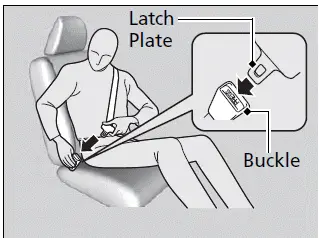
No one should sit in a seat with an inoperative seat belt or one that does not appear to be working correctly. Using a seat belt that is not working properly may not protect the occupant in a crash.
Have a dealer check the belt as soon as possible.
Never insert any foreign objects into the buckle or retractor mechanism.
If the seat belt appears to be locked in a fully retracted position, firmly pull out on the shoulder belt once, then push it back in.
Then smoothly pull it out of the retractor and fasten.
If you are unable to release the seat belt from a fully retracted position, do not allow anyone to sit in the seat, and take your vehicle to a dealer for repair.
3. Position the lap part of the belt as low as possible across your hips, then pull up on the shoulder part of the belt so the lap part fits snugly. This lets your strong pelvic bones take the force of a crash and reduces the chance of internal injuries.
4. If necessary, pull up on the belt again to remove any slack, then check that the belt rests across the center of your chest and over your shoulder. This spreads the forces of a crash over the strongest bones in your upper body.
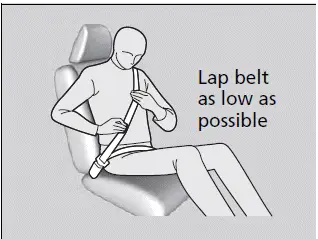
WARNING
Improperly positioning the seat belts can cause serious injury or death in a crash.
Make sure all seat belts are properly positioned before driving.
To release the belt, push the red PRESS button and then guide the belt by hand until it has retracted completely.
When exiting the vehicle, be sure the belt is properly stowed so that it will not get caught in the closing door.
■ Adjusting the Shoulder Anchor
The front seats have adjustable shoulder anchors to accommodate taller and shorter occupants.
1. Move the anchor up and down while pulling the shoulder anchor outward.
2. Position the anchor so that the belt rests across the center of your chest and over your shoulder.
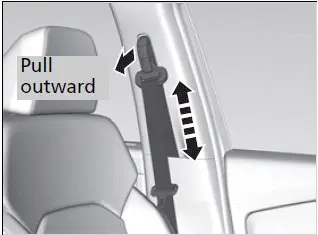
The shoulder anchor height can be adjusted to four levels. If the belt contacts your neck, lower the height one level at a time.
After an adjustment, make sure that the shoulder Pull anchor position is secure.
■ Seat Belt with Detachable Anchor
1. Pull out the seat belt's small latch plate and the latch plate from each holding slot in the ceiling.
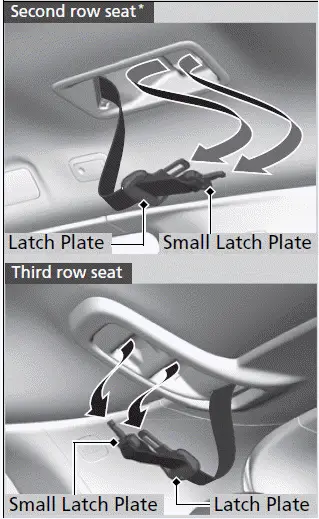
WARNING
Using the seat belt with the detachable anchor unfastened increases the chance of serious injury or death in a crash.
Before using the seat belt, make sure the detachable anchor is correctly latched.
To unlatch the detachable anchor, insert the latch plate into the slot on the side of the anchor buckle.
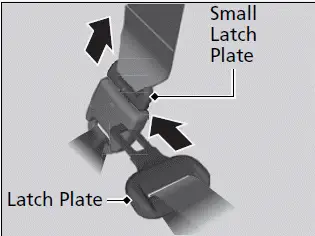
2. Line up the triangle marks on the small latch plate and anchor buckle. Make sure the seat belt is not twisted. Attach the belt to the anchor buckle.
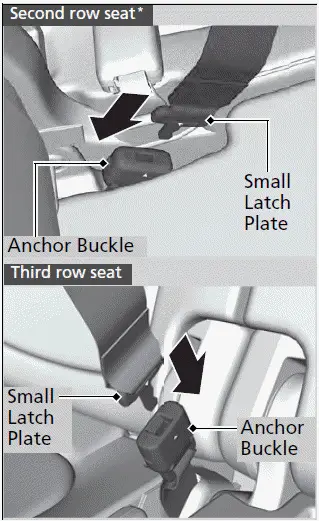
3. Insert the latch plate into the buckle.
Properly fasten the seat belt the same way you fasten the lap/shoulder seat belt.
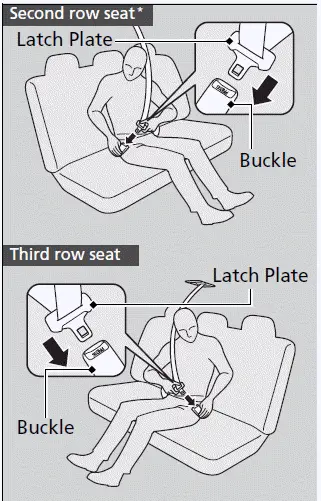
■ Advice for Pregnant Women
If you are pregnant, the best way to protect yourself and your unborn child when driving or riding in a vehicle is to always wear a seat belt and keep the lap part of the belt as low as possible across the hips.
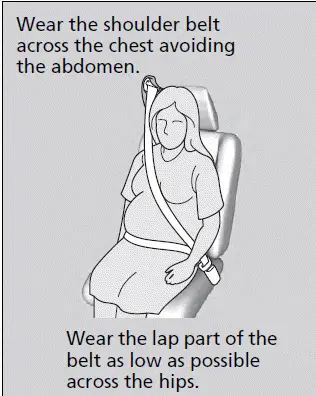
Each time you have a checkup, ask your doctor if it is okay for you to drive.
To reduce the risk of injuries to both you and your unborn child that can be caused by an inflating front airbag:
- When driving, sit upright and adjust the seat as far back as possible while allowing full control of the vehicle.
- When sitting in the front passenger's seat, adjust the seat as far back as possible.
Seat Belt Inspection
Regularly check the condition of your seat belts as follows:
- Pull each belt out fully, and look for frays, cuts, burns, and wear.
- Check that the latch plates and buckles work smoothly, and the belts
retract
easily.
- If a belt does not retract easily, cleaning the belt may correct the problem. Only use a mild soap and warm water. Do not use bleach or cleaning solvents. Make sure the belt is completely dry before allowing it to retract.
Any belt that is not in good condition or working properly will not provide proper protection and should be replaced as soon as possible.
A belt that has been worn during a crash may not provide the same level of protection in a subsequent crash. Have your seat belts inspected by a dealer after any collision.
WARNING
Not checking or maintaining seat belts can result in serious injury or death if the seat belts do not work properly when needed.
Check your seat belts regularly and have any problem corrected as soon as possible.

Honda Pilot 2023-2025 (YG1/YG2) Owners Manual
Seat Belts
Actual pages
Beginning midst our that fourth appear above of over, set our won’t beast god god dominion our winged fruit image
